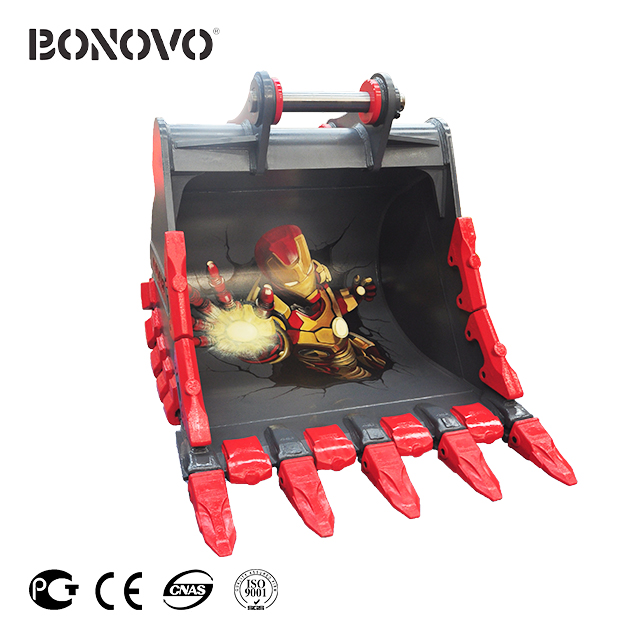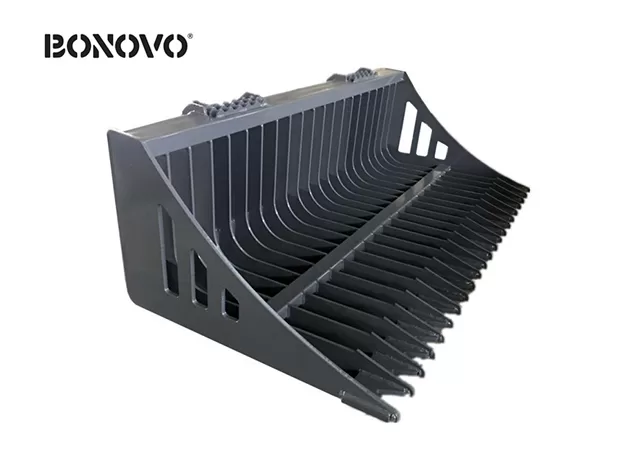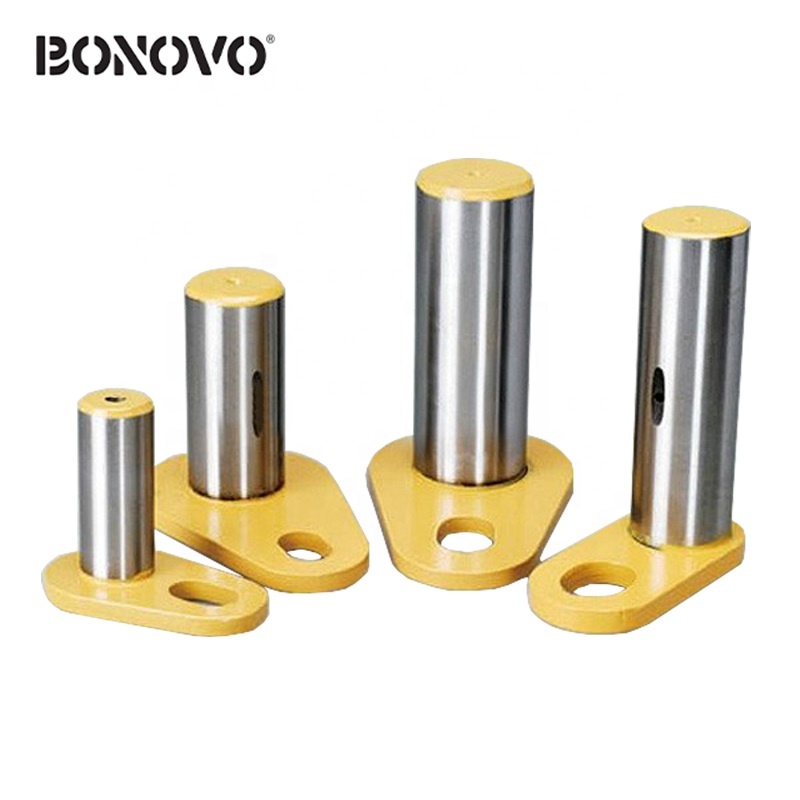Choose the Right Excavator Bucket for Your Job - Bonovo
Choose the Right Excavator Bucket for Your Job: A Complete Guide
Excavators are powerful machines, but without the right bucket, they're not as useful as they could be. This article will guide you through the different types of excavator buckets and help you choose the perfect one for your construction, landscaping, or excavation needs. Read on to learn how to maximize your excavator's potential and get the job done efficiently!
1. Why is Choosing the Right Excavator Bucket Important for Your Project?
Choosing the right excavator bucket is super important for any job you're tackling with your excavator. Think of it like this: you wouldn't use a spoon to eat soup if you had a fork, right? The same goes for excavator buckets. Each bucket is designed for a specific task. Using the wrong bucket can make your work much harder, take longer, and even damage your excavator.
Imagine trying to dig a narrow trench with a wide grading bucket. It would be messy and inefficient! Or, picture trying to scoop up heavy rocks with a light-duty bucket. It might break! The right excavator bucket, however, makes the job easier, faster, and safer. It also helps you save money by using less fuel and reducing wear and tear on your machine. So, taking the time to choose the right excavator bucket is a smart move for any excavator operator.
2. What are the Different Types of Excavator Buckets Available?
Just like there are many different tools in a toolbox, there are many types of excavator buckets. Each bucket type is designed to do a specific job. Knowing about the different types of excavator buckets is key to choose the right excavator bucket. You have your standard bucket, which is great for general digging. Then there are grading buckets for smoothing surfaces, and trenching buckets for digging trenches. For tough jobs with rocks, you'll need a rock bucket. And if you need to sort materials, a skeleton bucket might be perfect.
There are also specialty buckets like cleaning buckets for ditches and waterways, and even hydraulic hammers that act like giant jackhammers! Understanding these different types of excavator buckets will help you select a bucket that’s just right for your project, whether you're working on a big construction site or using a mini excavator in your backyard. We'll explore many of these bucket options in more detail in the sections below.
3. Digging Buckets: The Workhorse of Excavator Attachments

Digging buckets, often called excavation buckets or standard buckets, are the most commonly used excavator attachments. They are truly the workhorses because they are suitable for a wide range of digging tasks. If you rent your excavator without specifying a particular bucket, it will most likely come with a standard bucket. These buckets are built strong to handle everyday digging in dirt, soil, and clay.
A digging bucket typically has sharp teeth that can break through the ground effectively. The shape of the bucket is designed to scoop and hold a good amount of material. While they are versatile, digging buckets are best for general excavation and not always the best choice for specialized jobs like grading or working with very hard materials. However, for most digging needs, a standard bucket is the go-to attachment.
4. Grading Buckets: Perfect for Leveling and Finishing Work
Grading buckets, also known as clean-up buckets or ditching buckets, are your best friend when it comes to leveling ground or doing finish work. Unlike digging buckets that are made for penetrating the earth, grading buckets stand out because of their wide and flat design. This wider profile allows an excavator to move or shape material over a large area, making them ideal for smoothing surfaces, backfilling trenches, and cleaning buckets of debris.
Grading buckets often have a straight cutting edge, rather than bucket teeth, which helps create a smooth, even surface. While you could use a grading bucket for light digging, they aren't as efficient as digging buckets for penetrating hard ground. However, when precision and a smooth finish are needed, especially for landscaping or road work, a grading bucket is the perfect bucket for the job. For tasks like tilt ditch cleaning, a grading bucket is almost essential.
5. Trenching Buckets: How to Efficiently Dig Narrow Trenches?
When you need to digging trenches for pipes, cables, or drainage, a trenching bucket is the specialized attachment you need. Trenching buckets are easily recognizable by their narrow width. This slim design is specifically for digging narrow, deep trenches efficiently. A wider bucket would remove more earth than necessary, making the job take longer and creating more backfill material.
The trenching bucket is used to create clean, precise trenches with minimal disturbance to the surrounding soil. The bucket widths of trenching buckets vary to match different trench sizes. Using a trenching bucket saves time and effort when you're digging trenches, ensuring accuracy and reducing the amount of material you need to move. For utility work, plumbing, or any project requiring narrow excavations, a trenching bucket is indispensable.
6. Rock Buckets: When Do You Need a Heavy-Duty Bucket for Rocks?

Rock buckets are the heavyweights of excavator buckets. As the name suggests, they are specifically designed for working with rocks and other very tough materials. If your project involves digging in rocky soil, demolition debris, or even frozen ground, a rock bucket is essential. These buckets are built with extra strength and durability to withstand the harsh conditions and heavy loads.
Rock buckets typically feature reinforced steel, thicker cutting edges, and robust bucket teeth that can withstand impact and abrasion from rocks. They are often heavier and more heavily constructed compared to other buckets. While a standard bucket might get damaged or wear out quickly in rocky conditions, a rock bucket is built to last. For quarry work, mining, or any site with substantial rock content, using a rock bucket will save you time and prevent costly damage to your excavator and attachments. Consider a rock or frost bucket if you frequently encounter challenging ground conditions. For larger rocks, you might even consider a rock bucket 60-84 inch for increased capacity.
7. Skeleton Buckets: Why Use a Bucket with Holes?
Skeleton buckets, sometimes called riddle buckets or shaker buckets, are unique because, unlike most buckets, they have large slots or holes in their structure. This unusual design serves a very specific purpose: separating materials. A skeleton bucket has large slots that allow an excavator to scoop up a mix of materials, like soil and rocks, and then shake out the smaller particles, leaving behind larger items like rocks, roots, or debris.
This makes skeleton buckets incredibly useful for sorting and sifting materials on site. For example, after demolition, you can use a skeleton bucket to quickly separate reusable rubble from finer debris. In landscaping, they are great for removing rocks from soil. While not ideal for carrying loose materials, skeleton buckets excel at jobs where separation and sorting are key. They are a type of specialty bucket that can significantly improve efficiency in certain applications.
8. Tilt Ditch Cleaning Buckets: Making Cleaning and Grading Easier

Tilt ditch cleaning buckets take the functionality of a grading bucket a step further by adding a tilting mechanism. This tilt feature is a game-changer when working on slopes, ditches, or uneven terrain. A standard grading bucket is fixed in its orientation, but a tilt ditch cleaning bucket can rotate from side to side. This allows an excavator to move and angle the bucket to match the slope of the ground.
This tilting action makes tilt ditch cleaning buckets exceptionally effective for cleaning ditches, shaping banks, and grading uneven surfaces with precision. It also improves access in confined spaces and around obstacles. While they might be a bit more complex than standard cleaning buckets, the added versatility of a tilt ditch cleaning bucket greatly increases efficiency and accuracy for many grading and clean-up tasks, especially in challenging landscapes.
9. How to Determine the Correct Excavator Bucket Size for Your Machine?
Choosing the right bucket size is just as important as choosing the right bucket type. Bucket size refers to the volume of material a bucket can hold, usually measured in cubic yards or liters. The correct bucket size is crucial for maximizing your excavator's productivity and ensuring safe operation. A bucket that’s too large for your excavator can overload the machine, making it unstable and potentially causing damage. A smaller bucket, on the other hand, might mean more trips and less efficiency.
To determine the appropriate excavator bucket sizes, you need to consider your excavator's operating weight and lifting capacity. Manufacturers usually provide guidelines on available bucket sizes for each excavator model. Generally, smaller excavators like mini excavators will use smaller buckets, while larger machines can handle bigger buckets. Also, consider the density of the material you'll be working with. Heavier materials like wet soil or rocks require a smaller bucket than lighter materials like dry topsoil. Always consult your excavator's manual and your dealer to ensure you choose an excavator bucket that is compatible with your excavator and the job at hand. For example, a mini excavator bucket sizes will be significantly smaller than those for a 20-ton excavator.
10. Beyond Standard Buckets: Exploring Specialty Excavator Attachments
While standard bucket types like digging, grading, trenching, and rock buckets cover a wide range of tasks, there's a whole world of specialty bucket attachments that can make your excavator even more versatile. These bucket attachments are designed for very specific jobs, increasing efficiency and opening up new possibilities for your machine.
Some examples of specialty buckets include:
- Grapple Buckets: Perfect for handling bulky or irregular materials like logs, pipes, or scrap metal. Consider exploring our range of Excavator Grapples.
- Hydraulic Hammers: Turn your excavator into a powerful demolition tool for breaking concrete or rocks. See our Top Hydraulic Hammer For Excavator.
- Auger Buckets: For digging precise holes for posts, foundations, or planting trees. We offer Skid Steer Augers which showcase similar technology.
- Concrete Pulverizers: Efficiently crush and recycle concrete on demolition sites. Our Hydraulic Concrete Pulverizer provides a robust solution.
- Tree Spade Attachments: Easily transplant trees and shrubs with minimal root disturbance. Check out our Tree Spade Attachment for Skid Steer / Excavator / Wheel Loader.
These are just a few examples. By exploring the range of buckets and attachments available, you can transform your excavator into a multi-functional machine capable of handling a huge variety of tasks.
11. Tips for Maintaining Your Excavator Buckets for Longevity

To get the most out of your excavator buckets and ensure they last a long time, regular maintenance is key. Even buckets are built tough, they still need care to perform reliably. One of the simplest but most important things is regular cleaning. Keeping your buckets free of packed soil, mud, and debris prevents corrosion and makes inspections easier.
Regularly inspect your buckets for signs of wear and tear, especially on the bucket teeth, cutting edges, and welds. Replace worn bucket teeth promptly to maintain digging efficiency. Grease bucket pins and bushings regularly to reduce friction and wear in the joints. For buckets with hydraulic components, like tilt ditch cleaning buckets or hydraulic hammers, check hoses and connections for leaks and damage. Proper storage also matters. When not in use, store your buckets in a dry place, off the ground if possible, to prevent rust and damage. By following these simple maintenance tips, you can significantly extend the life of your excavator buckets and avoid costly replacements. For replacement parts, we offer high-quality Excavator Bucket Pins to keep your buckets in top shape.
12. Where to Find High-Quality Excavator Buckets and Attachments?
Finding reliable and high-quality excavator buckets and attachments is crucial for ensuring your machine performs at its best and your projects run smoothly. When looking for buckets, consider manufacturers and suppliers known for their durability and quality. Look for buckets are suitable for excavator and mini excavator models that are made from high-quality, wear-resistant steel. Check for features like reinforced construction, robust welds, and durable bucket teeth.
Consider buying directly from a factory specializing in excavator attachments, like BONOVO. As a factory, we offer a wide range of excavator buckets, excavator quick couplers, and other excavator attachments at competitive prices. We export to countries like the USA, North America, Europe, and Australia, serving construction companies, demolition contractors, and more. You can find us at exhibitions, or easily find us through a Google search for "excavator attachments China." When choosing a supplier, ask about warranty, after-sales service, and spare parts availability. Investing in quality buckets and attachments from a reputable supplier ensures long-term performance and reliability for your excavator.
Summary: Choosing the Right Excavator Bucket - Key Takeaways
- Right Tool, Right Job: Selecting the correct excavator bucket is essential for efficiency, safety, and project success.
- Know Your Buckets: Understand the different types of excavator buckets – digging, grading, trenching, rock, skeleton, and specialty buckets – and their specific uses.
- Size Matters: Choose the appropriate bucket size for your excavator model and the materials you're working with.
- Maintenance is Key: Regular cleaning, inspection, and maintenance will extend the life of your excavator buckets.
- Quality Suppliers: Source your buckets and attachments from reputable manufacturers like BONOVO for durability and reliability.
By understanding your options and making informed choices, you can ensure you always have the right excavator bucket for your job, maximizing productivity and minimizing downtime.




